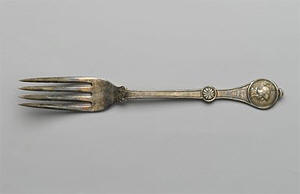| |
| |
|
|
|
| |
| |
THE MID-18th CENTURY'S HOTTEST ITEM
-- THE KNIFE & FORK SET
In his first four months
of business as a general store proprietor, Nicholas
Dupui somehow managed to sell a total of 50 knife
and fork sets. So what was going on? Why
was cutlery, of all things, the hottest item in the
market?
As it turns out, the newly-introduced German four
tined curved fork was the technological marvel of
the day, an invention unlike any other, and just
like a brand new
iPhone that has massive crowds
thronging to the store, everyone that was anyone in
Northampton County absolutely had to have a brand
new knife and fork set. It was a de
rigueur
consideration, and one could almost hear them
humming: "The Tines They Are a Changing".
With prices at a bargain basement level
(1.5, 2, or 2.5 shillings for a knive and
fork set -- clearly, different quality
levels were offered), this new type of
cutlery obviously enjoyed enormous
popularity. If purchased for tabletop
settings by the half-dozen unit, they were
even cheaper (coming in at 8-9 shillings for
the six knive and six fork set).
As to the nature of the knife, all that we
know is that Dupui had been selling three
types of knives at his establishment: the
basic knife (1 shilling, 3 pence), the clasp
knife (1 shilling, 6 pence), and the
brass-handled pen knife (2 shillings, 6
pence). Doubtless the knife that was sold
along with the fork must have been styled as
part of a matching set. |
|
 |
We're told that "by the 18th
century, curved forks with tines were increasingly used
in order to defeat food such as peas." The observation
happens to accord with the sales logged to the Dupui
ledger. During the same time frame as the sale of knife
and fork sets, we note the repeated sale of peas by
both skippel and half-bushel quantities.
Silverware defined the aristocratic life, so we don't
find it surprising to discover that one of the area's
other prominent businessmen, James Hyndshaw, local
sawmill proprietor (after whom a fort would later be
named), was among those select few that purchased knife
and fork sets by the half-dozen unit. His guests would
have the best. Notably, it was also James Hyndshaw who
appears in the ledger as also having purchased a
107-gallon barrel of rum.
|
|
| |
|
|
|
|
|
| |
|
|
|
| |
|
|
|
| |
|
|
| |
|
|
|
|